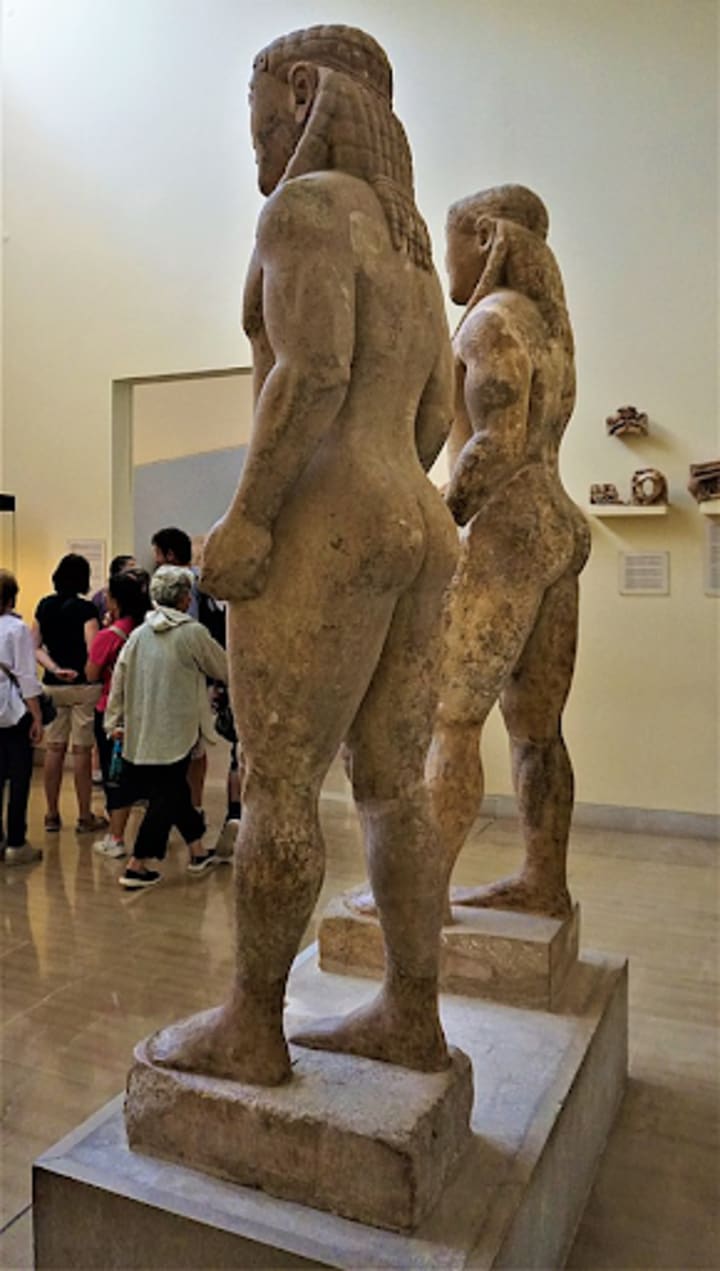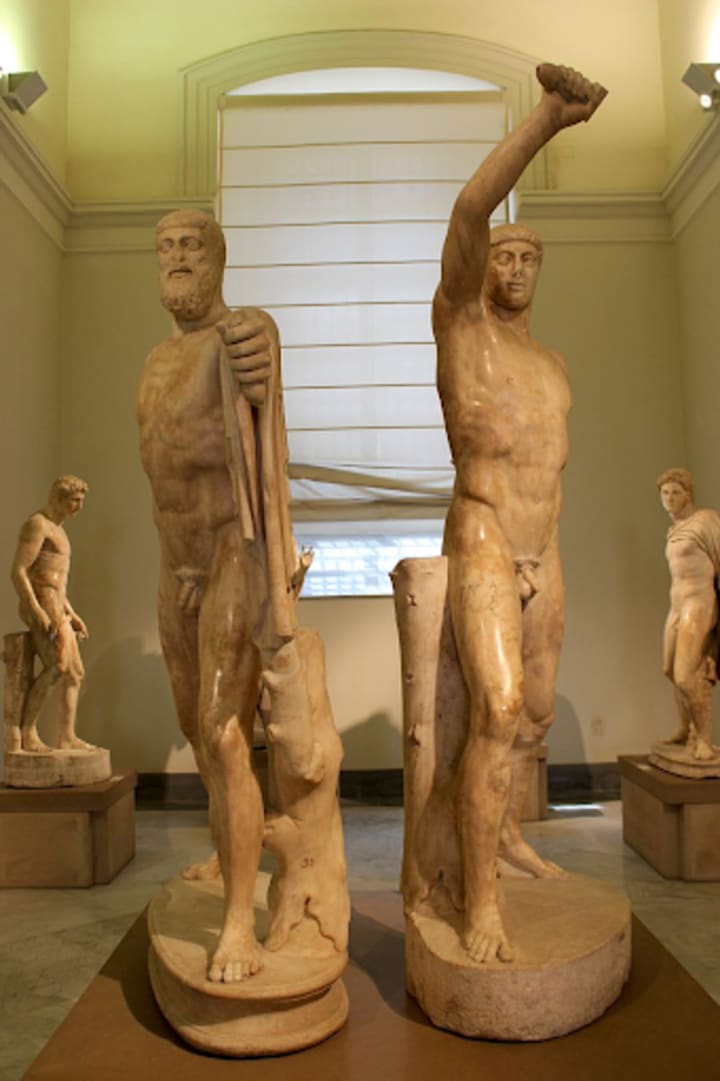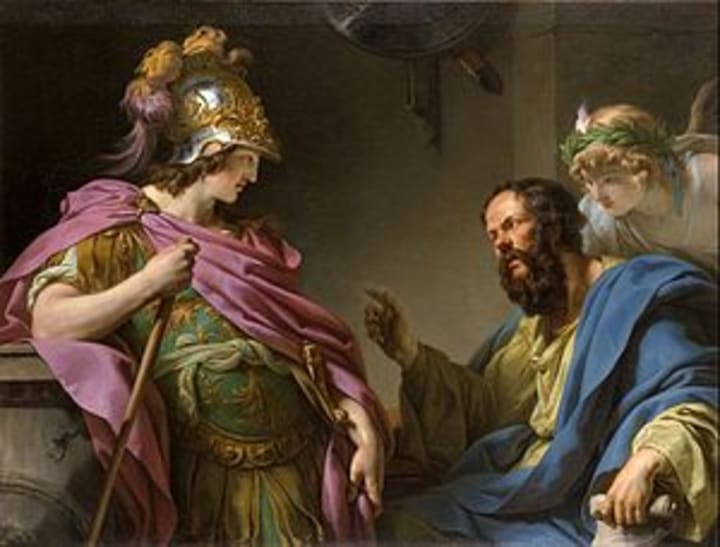Being Gay in Ancient Greece and Rome
10 Ancient Greek and Roman LGBTQIA+ figures you need to know about

The Ancient Greeks and Romans had very different ideas of sexuality and gender than we do today. Bisexuality was considered the natural state for men in the Ancient World, and male homosexuality was also accepted. Unfortunately, we know very little about queer women in Ancient Greece and Rome—female queerness was mostly ignored by Greco-Roman society, except in Lesbos and Sparta. As for gender, the Greeks and Romans had some concept of a third sex and transgender priestesses were common in certain cults such as that of Cybele. However, unfortunately, just as with lesbians, we have few examples of real life trans people in Ancient Greece and Rome. Our ancient texts are awash with prominent bisexual and gay men, but unfortunately very few queer women or trans people. But here is a very incomplete list of 10 Ancient Greek and Roman LGBTQIA+ figures you need to know about.
1. Sappho
We all have heard of Sappho (c. 630 BCE- c. 570 BCE), after all, she’s probably history’s most famous lesbian—the origin of the both “sapphic” and “lesbian”, which is named after the island of Lesbos (modern Lesvos) where she lived. Sappho was a poet and we still have several of her poems, that depict lesbian love with gorgeous natural metaphors. As well as poetry, Sappho also had an eventful life, being exiled with her family due to regime change in her native city of Mytilene.
2. Solon
Solon (c. 630 BCE- c. 560 BCE) is known as one of the seven sages of Ancient Greece (and less so as an Athenian lawmaker), but he was also very interested in men. From the fragments of his lyric poetry, we learn what Greek statues make us suspect, that the Ancient Greeks really liked butts and thighs. Unfortunately, we don’t actually know for certain the names of any of his lovers, though the Athenian tyrant Peisistratus might have been one of them (or this could be an invention of the melodramatic Greeks).

3. Harmodius and Aristogeiton
The lovers Harmodius and Aristogeiton were known in Ancient Athens as the “tyrannicides”, for their role in bringing down the tyrants of Athens. Harmodius and Aristogeiton decided to kill the tyrant Hippias and his brother Hipparchus because Hipparchus, after being rejected by Harmodius, shamed his sister. They only succeeded in killing Hipparchus (and died themselves in the attempt), but they were honoured in Athens both as the killers of a tyrant and as the ideal of Ancient Greek homosexuality.

4. Sophocles
The playwright Sophocles (497/6 BCE- 406/5 BCE) is famous as the author of Oedipus Rex and Antigone. He was very into men, and several anecdotes exist of his sexual exploits. Once a boy he slept with stole his cloak, leaving his own in its place, and Euripides, another of the three extant Greek tragedians, ridiculed Sophocles, saying that he didn’t get robbed when he slept with the same boy.
5. Alcibiades
Alcibiades (450 BCE- 404 BCE) was an Athenian general at the close of the fifth century BCE. He was said to be extremely handsome and was very bi. Along with his many other conquests, he may have been the lover of Socrates, though Plato says in the Symposium that Alcibiades tried and failed to seduce Socrates.

6. Plato
Plato (428/7 or 424/3 BCE- 348/7 BCE), the philosopher, was not into women at all. Perhaps this can be seen in his works, such as in the Symposium where he has Aristophanes give an origin myth in which humans originally had two halves, which were then separated to become soul mates. Lesbians are barely mentioned, but straight people really cop it—Plato says that the gods invented them to commit adultery, whereas gay men have the most pure relationships and only marry women for the sake of offspring.
7. Epaminondas
Epaminondas (c. 418 BCE- 362 BCE) was a brilliant Theban general, responsible for briefly making Thebes the foremost power in Greece and the downfall of Sparta. We know that he was gay and not bi, because he had male lovers and never got married— when questioned about his legacy, he said that his battles were his children. He had two known lovers Asopichus and Caphisodorus. Caphisodorus died at his side during the battle of Mantinea and the pair were buried together. Epaminondas also may have also been involved in the Sacred Band of Thebes, an elite unit of soldiers entirely made up of gay lovers.
8. Alexander the Great
Along with marrying several times and carrying on multiple affairs with both men and women, Alexander the Great (356 BCE- 323 BCE) had a lifelong relationship with his friend Hephaestion. Modern scholars love discussing whether Alexander and Hephaestion were really a thing, but there’s plenty of evidence they were—like other homosexual Greek couples, the pair made oaths to each other on the tomb of Achilles and Patrocles, who were recognised as lovers by the Ancient Greeks. They even married sisters, which is a good indication they were very close. And after Hephaestion’s death, Alexander had to be dragged away from his dead body, spent a fortune on Hephaistion’s funeral (especially the huge funeral pyre) and then had him made into a divine hero so he could be worshipped. Alexander himself died eight months later.
9. Nero
Nero (37 AD- 69 AD) definitely isn’t a great queer role model, but he deserves a mention. A form of gay marriage existed in Ancient Rome, and Nero married two different men. Nero married his first husband, Pythagoras, while dressed as a woman, which caused great scandal at the time. But Nero’s second marriage was even more famous—after the death of his wife, he castrated Sporus, one of his freedmen, dressed him as his wife and married him.
10. Elagabalus
Elagabalus (c. 204 AD- 222 AD) might have been Rome’s first trans emperor. They asked people to refer to them as a lady instead of a lord and loved being referred to as their boyfriend Hierocles’ wife, mistress or queen. They also apparently offered a reward to any surgeon who could equip them with a vagina—possibly making the world’s first request for sexual reassignment surgery.
11. Hadrian and Antinous
Hadrian (76 AD-138 AD) was a Roman Emperor who was gay—not bisexual as the standards of the time expected. His partner was Antinous, who was known for his beauty. However, Antinous drowned on a trip on the Nile. A distraught Hadrian, like Alexander the Great before him, had his lover deified, creating a popular cult. And why not—Antinous was gorgeous, as the statues of him we still have show us:
We don’t know what pronouns Elegabalus would have used, so I’m just going to use “they”.

Conclusion:
Being bisexual or gay in Ancient Greece and Rome was not judged in the way it is now, so we know of plenty of figures who we would consider LGBTQIA+. It is a great time to look back at to remember that the modern preoccupation with straightness is just a cultural trend.
About the Creator
A. Walter Cox
Enjoyed the story? Support the Creator.
Subscribe for free to receive all their stories in your feed. You could also pledge your support or give them a one-off tip, letting them know you appreciate their work.







Comments
There are no comments for this story
Be the first to respond and start the conversation.